Analysis of the Characteristics of Climate Change in the Ecologically Vulnerable Area of the Mu Us Dune Field under the Background of Global Warming
Abstract
1. Introduction
2. Material and Methods
2.1. Research Area
2.2. China Meteorological Data Service Center
2.3. ECMWF Data
2.4. Statistical Analysis for Climatic Processing
3. Results
3.1. Principal Component Analysis of Temperature, Precipitation, and PWV
3.2. Analysis of Time Variation Characteristics of Temperature, Precipitation, and PWV
3.3. Analysis of the Spatial Distribution Characteristics of Temperature, Precipitation, and PWV
4. Discussion
4.1. Responses of Temperature, Precipitation, and PWV to Global Warming
4.2. Effects of Temperature, Precipitation, and PWV on Vegetation Coverage
4.3. Effects of Human Practices on Vegetation Coverage
5. Conclusions
Author Contributions
Funding
Institutional Review Board Statement
Informed Consent Statement
Data Availability Statement
Acknowledgments
Conflicts of Interest
References
- Diaz, H.F.; Bradley, R.S.; Eischeid, J.K. Precipitation fluctuations over global land areas since the late 1800’s. J. Geophys. Res. Atmos. 1989, 94, 1195–1210. [Google Scholar] [CrossRef]
- Hansen, J.; Lebedeff, S. Global trends of measured surface air temperature. J. Geophys. Res. 1987, 92, 13345–13372. [Google Scholar] [CrossRef]
- Hansen, J.; Lebedeff, S. Global surface air temperatures: Update through 1987. Geophys. Res. Lett. 2013, 15, 323–326. [Google Scholar] [CrossRef]
- Jones, P.D.; Raper, S.C.B.; Bradley, R.S.; Diaz, H.F.; Wigley, T.M.L. Northern Hemisphere Surface Air Temperature Variations: 1851–1984. J. Appl. Meteorol. 1986, 25, 161–179. [Google Scholar] [CrossRef]
- Jones, P.D.; Wigley, T.M.L.; Wright, P.B. Global temperature variations between 1861 and 1984. Nature 1986, 322, 430–434. [Google Scholar] [CrossRef]
- Kumar, P.; Sharma, M.C.; Saini, R.; Singh, G.K. Climatic variability at Gangtok and Tadong weather observatories in Sikkim, India, during 1961–2017. Sci. Rep. 2020, 10, 15177. [Google Scholar] [CrossRef]
- Yang, L.; Wylie, B.K.; Tieszen, L.L.; Reed, B.C. An Analysis of Relationships among Climate Forcing and Time-Integrated NDVI of Grasslands over the U.S. Northern and Central Great Plains. Remote Sens. Environ. 1998, 65, 25–37. [Google Scholar] [CrossRef]
- Feng, Y. Vegetation Coverage Change in Mu Us Sandy Land and Its Response to Climate Change. Ph.D. Thesis, Beijing Forestry University, Beijing, China, 2015. [Google Scholar]
- Kawabata, A.; Ichii, K.; Yamaguchi, Y. Global monitoring of interannual changes in vegetation activities using NDVI and its relationships to temperature and precipitation. Int. J. Remote Sens. 2001, 22, 1377–1382. [Google Scholar] [CrossRef]
- Ma, D.; Notaro, M.; Liu, Z.; Chen, G.; Liu, Y. Simulated impacts of afforestation in East China monsoon region as modulated by ocean variability. Clim. Dyn. 2013, 41, 2439–2450. [Google Scholar] [CrossRef]
- Gao, X.; Zhao, Z.; Ding, Y. The Greenhouse Effect Caused by the Numerical Simulation of China Regional Climate Change Ⅰ: Mode of China’s Climate Simulation Ability Test. J. Meteorol. 2003, 61, 20–28. [Google Scholar]
- Huang, J.; Wen, C.; Wen, Z.; Zhang, G.; Li, Z. Atmospheric Science in China Since the Founding of New China 70 Years Ago: Climate and Climate Change. Sci. Sin. 2019, 49, 1607–1640. [Google Scholar]
- Jia, Y.; Bo, Z.; Bin, M.; Bin, C.; Wu, Q. Spatio-temporal evolution characteristics of persistent drought in Southwest China in 1960–2015. J. Arid Land Resour. Environ. 2019, 5, 171–176. [Google Scholar]
- Bin, M.; Bo, Z. Spatio-temporal distribution of the climatic seasons in China from 1961 to 2016. Acta Geogr. Sin. 2020, 75, 458–469. [Google Scholar]
- Ma, P.; Han, L.; Zhang, X.; Liu, W. Regional Characteristics of Drought in China under the Background of Climate Warming. J. Desert Res. 2019, 39, 209–215. [Google Scholar]
- Wu, S.; Yong, L.; Hao, W.; Wang, J. Climate change impacts and Adaptation in China: Trends and Prospects. Chin. Sci. Bull. 2016, 61, 1042–1054. [Google Scholar]
- Zhang, D.; Gao, X. RegCM3 High Resolution Simulation of China’s Regional Climate Change in the 21st Century. Chin. Sci. Bull. 2020, 65, 2516–2526. [Google Scholar]
- Department of Geography Panjab University. The Natural Conditions and Their Improved Utilization in the Mu Us Dune Field; Science Press: Beijing, China, 1983. [Google Scholar]
- Zhu, F. Temporal and Spatial Changes of Desertification and Climate Impacts in the Four Sandy Lands of Northern China in the Past 30 Years. Ph.D. Thesis, Nanjing University, Nanjing, China, 2015. [Google Scholar]
- Liu, D.; Yan, Y. Spatial differentiation of climate changes in MU US desert region. Resour. Sci. 2003, 25, 71–76. [Google Scholar]
- Liu, D.; Zhang, Y. The Characteristics of Climate Changes in Mu Us Desert Under Global Climate Changes. J. Arid Land Resour. Environ. 2003, 17, 78–81. [Google Scholar]
- He, T. The Environment Change of Mu Us Desert in Historical Period. Ph.D. Thesis, Lanzhou University, Lanzhou, China, 2008. [Google Scholar]
- Wu, X.; Yu, W.; Liang, Z. Spatio Temporal Distribution and Variation Trend of Temperature and Precipitation over China Based on High Resolution Gridded Datasets. Meteorol. Disaster Reduct. Res. 2016, 39, 241–251. [Google Scholar]
- Wang, S.; Xu, T.; Nie, W.; Jiang, C.; Zhang, Z. Evaluation of Precipitable Water Vapor from Five Reanalysis Products with Ground-Based GNSS Observations. Remote Sens. 2020, 12, 1817. [Google Scholar] [CrossRef]
- Yao, Y.; Lei, X.; Liang, Z.; Bao, Z.; Hai, P.; Zhang, J. Analysis of precipitable water vapor and surface temperature variation over Qinghai-Tibetan Plateau from 1979 to 2014. Chin. Sci. Bull. 2016, 61, 1462–1477. [Google Scholar] [CrossRef]
- Zhao, C.; Wang, Y.; Ding, Y. Spatial-Temporal Variations of Temperature and Precipitation in Northern China in Recent 50 Years. Plateau Meteorol. 2011, 30, 385–390. [Google Scholar]
- Chen, J.; Liu, Y.; Tao, P.; Wu, H. Spatiotemporal Variation of Precipitation in China and Its Impact on Surface Dry-Wet Conditions During 1961–2010. J. Nat. Resour. 2019, 34, 2440–2453. [Google Scholar]
- Shang, S.; Lian, L.; Ting, M.; Kun, Z.; Tuo, H. Spatiotemporal Variation of Temperature and Precipitation in Northwest China in Recent 54 Years. Arid Zone Res. 2018, 35, 68–76. [Google Scholar]
- Yao, J.; Qing, Y.; Chen, Y.; Hu, W. Climate change in arid areas of Northwest China in past 50 years and its effects on the local ecological environment. J. Nat. Resour. 2013, 32, 1283. [Google Scholar]
- Miao, W. The Influence of Vegetation Change in Northwest Region on China’s Summer Climate. Master’s Thesis, Lanzhou University, Lanzhou, China, 2018. [Google Scholar]
- Xu, Z.; Rui, H.; Wang, K.; Mason, J.A.; Wu, S.; Lu, H. Recent greening (1981–2013) in the Mu Us dune field, north-central China, and its potential causes. Land Degrad. Dev. 2018, 29, 1509–1520. [Google Scholar] [CrossRef]
- Li, Q. Spatial-temporal pattern of vegetation coverage in Northwest China and its response to climate change. J. Northwest Univ. 2012, 4, 667–672. [Google Scholar]
- Li, D.; Zhao, W. Changes of fractional vegetation coverage after returning farmland to forests and its response to climate in Shaanxi. J. Nat. Resour. 2020, 39, 1–10. [Google Scholar]
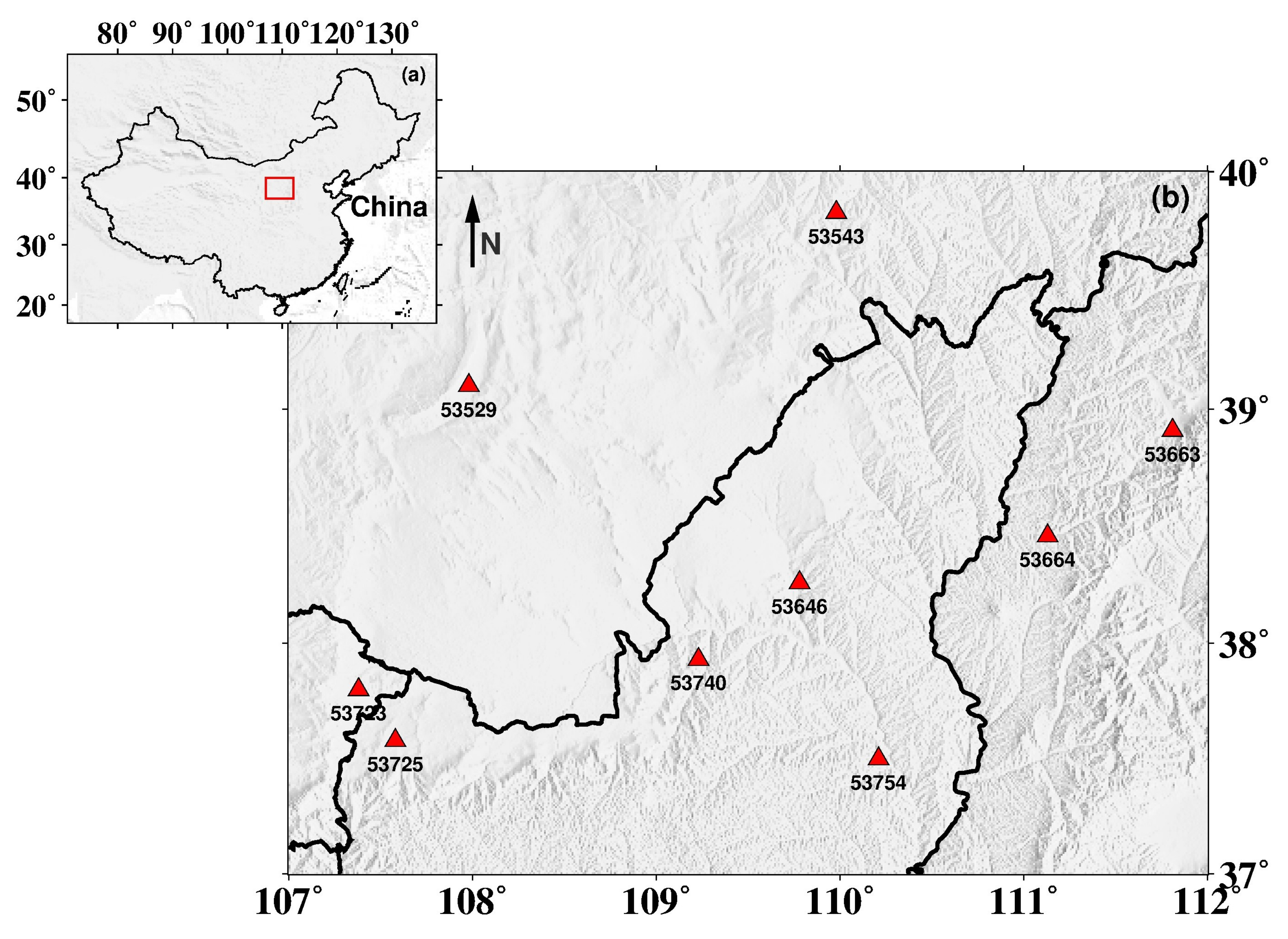
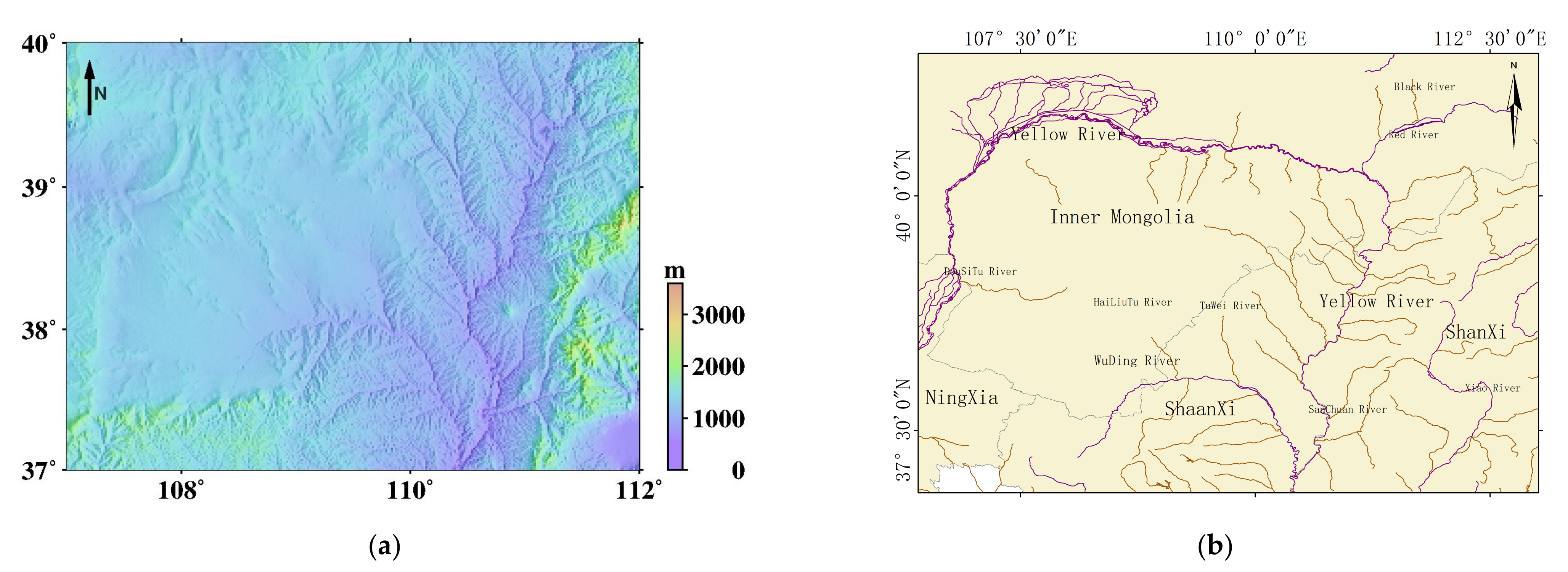




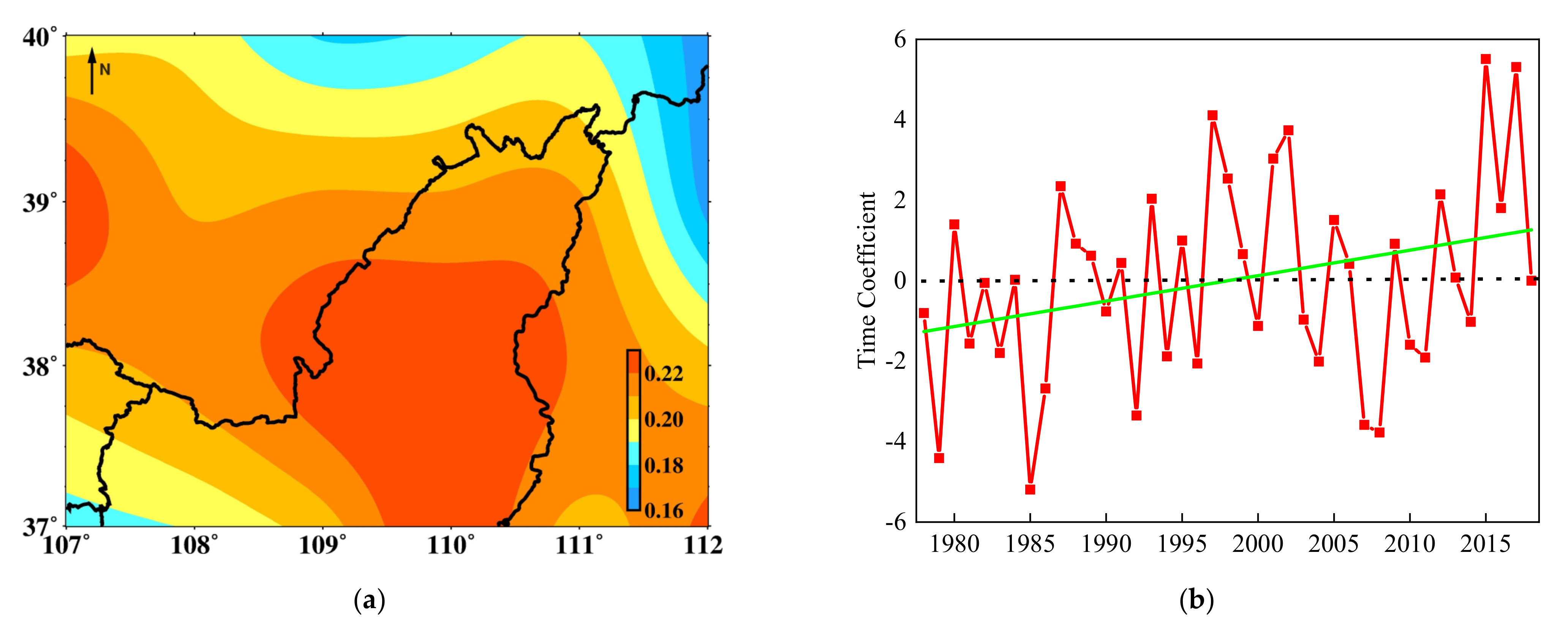
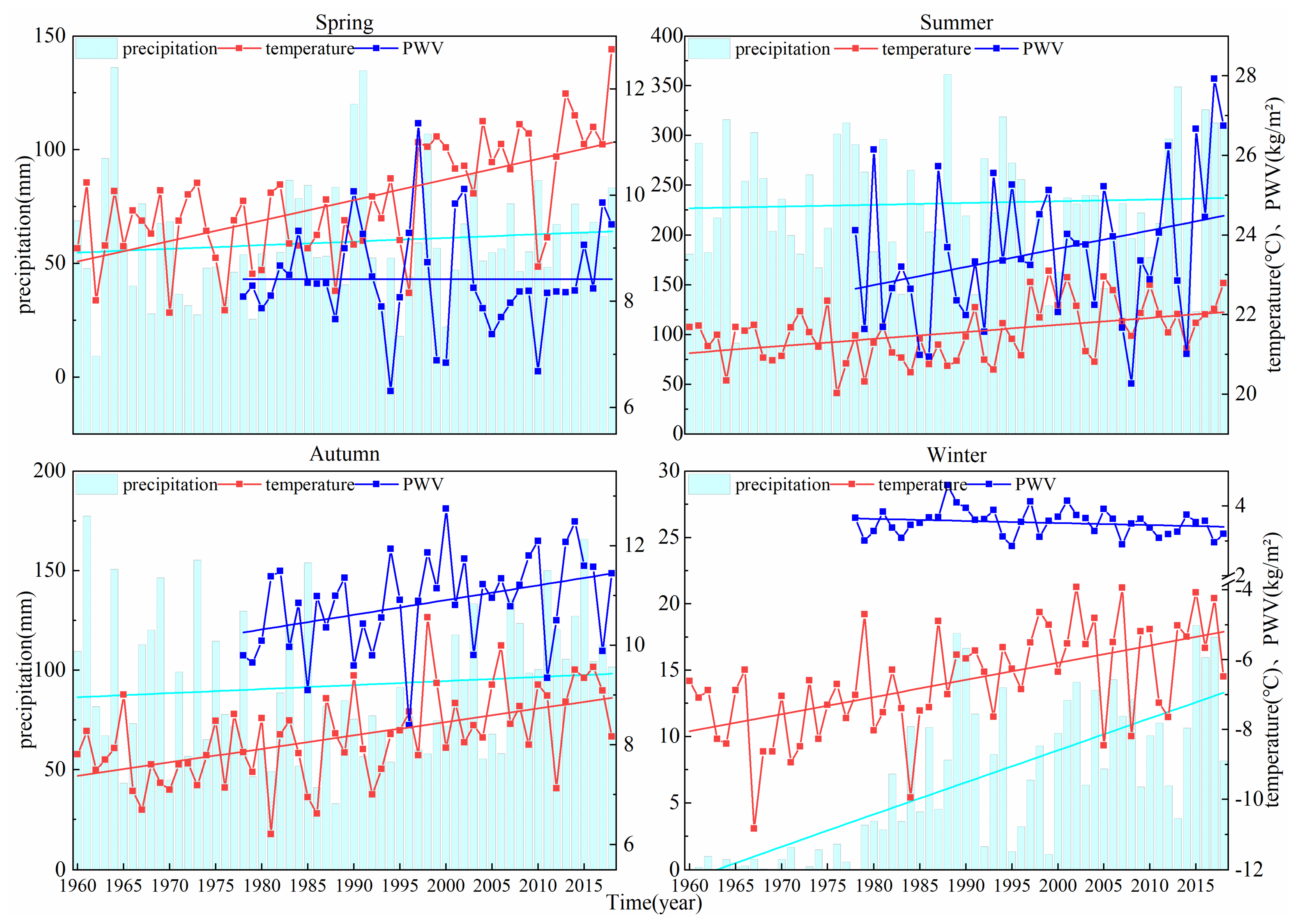

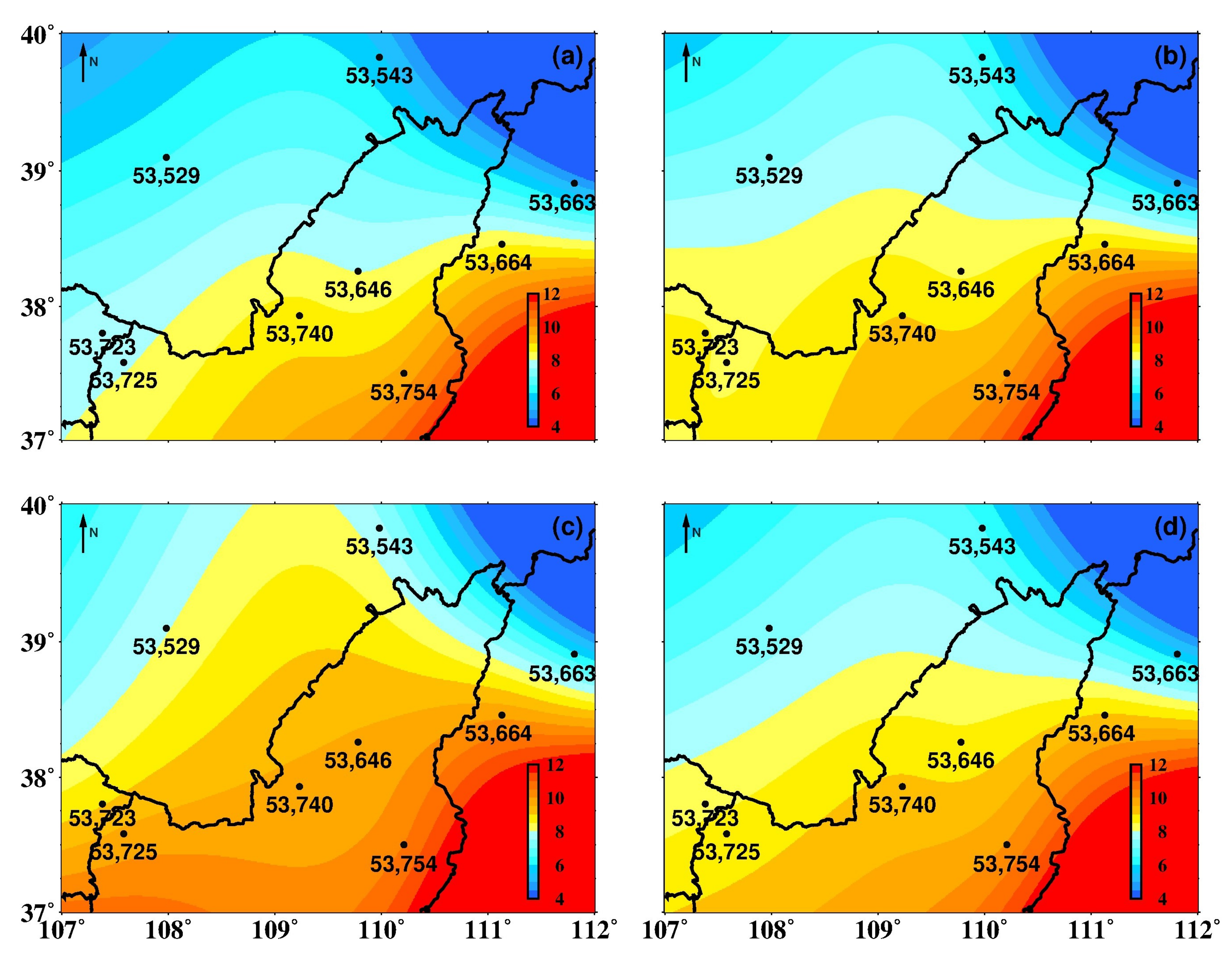
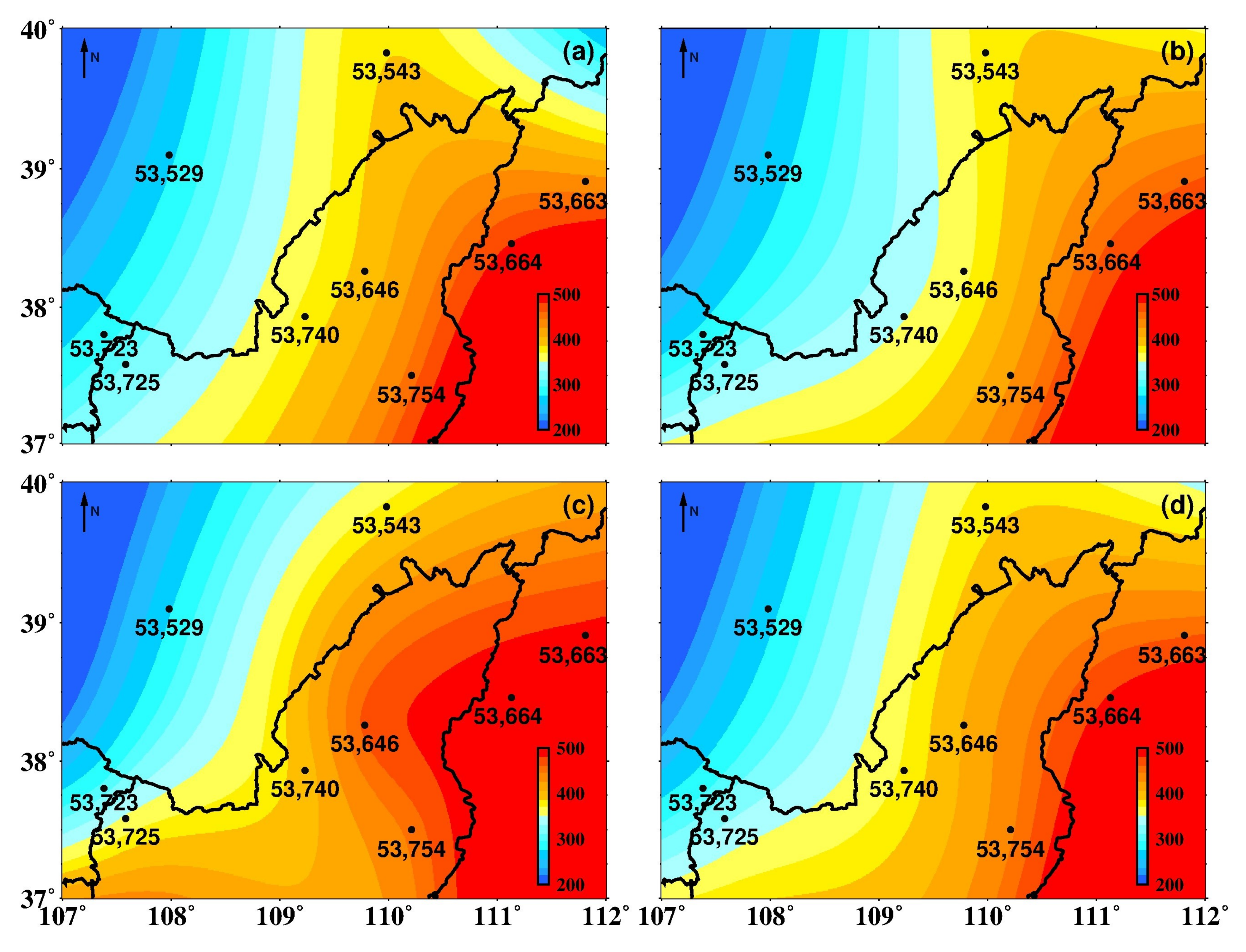

| Station-Number | Name | Province | Latitude (°) | Longitude (°) | Altitude (m) |
|---|---|---|---|---|---|
| 53529 | Etuoke-Banner | Inner-Mongolia | 39.1 | 107.98 | 1380.3 |
| 53543 | Dong Sheng | Inner-Mongolia | 39.83 | 109.98 | 1461.9 |
| 53646 | Yu Lin | Shaan Xi | 38.26 | 109.78 | 1157 |
| 53663 | Wu Zhai | Shan Xi | 38.91 | 111.81 | 1401 |
| 53725 | Ding Bian | Shaan Xi | 37.58 | 107.58 | 1360.3 |
| 53723 | Yan Chi | Ning Xia | 37.80 | 107.38 | 1349.3 |
| 53754 | Sui De | Shaan Xi | 37.50 | 110.21 | 929.7 |
| 53664 | Xing Xian | Shan Xi | 38.46 | 111.13 | 1012.6 |
| 53740 | Heng Shan | Shaan Xi | 37.93 | 109.23 | 1111 |
| Variance Contribution Rate | I | II | III |
|---|---|---|---|
| Temperature | 95.04 1 | 1.77 | 1.31 |
| Precipitation | 61.68 1 | 10.29 1 | 9.35 1 |
| PWV | 92.66 1 | 4.27 | 2.01 |
Publisher’s Note: MDPI stays neutral with regard to jurisdictional claims in published maps and institutional affiliations. |
© 2021 by the authors. Licensee MDPI, Basel, Switzerland. This article is an open access article distributed under the terms and conditions of the Creative Commons Attribution (CC BY) license (http://creativecommons.org/licenses/by/4.0/).
Share and Cite
Huang, G.; Zhu, H.; Zhang, J.; Liu, B. Analysis of the Characteristics of Climate Change in the Ecologically Vulnerable Area of the Mu Us Dune Field under the Background of Global Warming. Remote Sens. 2021, 13, 627. https://doi.org/10.3390/rs13040627
Huang G, Zhu H, Zhang J, Liu B. Analysis of the Characteristics of Climate Change in the Ecologically Vulnerable Area of the Mu Us Dune Field under the Background of Global Warming. Remote Sensing. 2021; 13(4):627. https://doi.org/10.3390/rs13040627
Chicago/Turabian StyleHuang, Guanwen, Hai Zhu, Juqing Zhang, and Bohan Liu. 2021. "Analysis of the Characteristics of Climate Change in the Ecologically Vulnerable Area of the Mu Us Dune Field under the Background of Global Warming" Remote Sensing 13, no. 4: 627. https://doi.org/10.3390/rs13040627
APA StyleHuang, G., Zhu, H., Zhang, J., & Liu, B. (2021). Analysis of the Characteristics of Climate Change in the Ecologically Vulnerable Area of the Mu Us Dune Field under the Background of Global Warming. Remote Sensing, 13(4), 627. https://doi.org/10.3390/rs13040627






